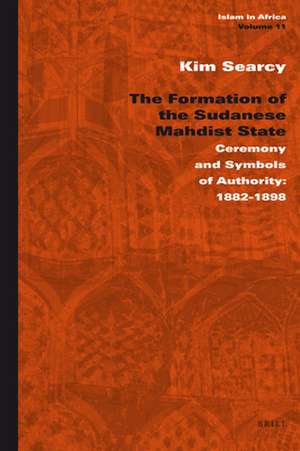The Formation of the Sudanese Mahdist State: Ceremony and Symbols of Authority: 1882-1898: Islam in Africa, cartea 11
Autor Kim Searcyen Limba Engleză Hardback – 16 dec 2010
Din seria Islam in Africa
- 18%
 Preț: 721.44 lei
Preț: 721.44 lei - 18%
 Preț: 1374.54 lei
Preț: 1374.54 lei - 18%
 Preț: 868.62 lei
Preț: 868.62 lei - 18%
 Preț: 869.33 lei
Preț: 869.33 lei - 18%
 Preț: 888.01 lei
Preț: 888.01 lei - 18%
 Preț: 696.64 lei
Preț: 696.64 lei - 18%
 Preț: 635.76 lei
Preț: 635.76 lei - 22%
 Preț: 678.05 lei
Preț: 678.05 lei - 18%
 Preț: 723.40 lei
Preț: 723.40 lei - 18%
 Preț: 576.05 lei
Preț: 576.05 lei - 18%
 Preț: 610.42 lei
Preț: 610.42 lei - 18%
 Preț: 635.13 lei
Preț: 635.13 lei - 18%
 Preț: 590.65 lei
Preț: 590.65 lei - 18%
 Preț: 591.20 lei
Preț: 591.20 lei - 18%
 Preț: 591.58 lei
Preț: 591.58 lei - 18%
 Preț: 682.98 lei
Preț: 682.98 lei - 18%
 Preț: 722.09 lei
Preț: 722.09 lei - 18%
 Preț: 683.69 lei
Preț: 683.69 lei - 18%
 Preț: 810.09 lei
Preț: 810.09 lei - 18%
 Preț: 649.55 lei
Preț: 649.55 lei - 18%
 Preț: 598.27 lei
Preț: 598.27 lei
Preț: 598.44 lei
Preț vechi: 729.80 lei
-18% Nou
Puncte Express: 898
Preț estimativ în valută:
114.52€ • 118.89$ • 95.50£
114.52€ • 118.89$ • 95.50£
Carte indisponibilă temporar
Doresc să fiu notificat când acest titlu va fi disponibil:
Se trimite...
Preluare comenzi: 021 569.72.76
Specificații
ISBN-13: 9789004185999
ISBN-10: 9004185992
Pagini: 166
Dimensiuni: 160 x 240 mm
Greutate: 0.34 kg
Editura: Brill
Colecția Brill
Seria Islam in Africa
ISBN-10: 9004185992
Pagini: 166
Dimensiuni: 160 x 240 mm
Greutate: 0.34 kg
Editura: Brill
Colecția Brill
Seria Islam in Africa
Notă biografică
Kim Searcy is an assistant professor of history at Loyola University, Chicago. He is an Islamicist trained in African history, focusing primarily on Islamic Revival and Reform in the Sudan in the 19th century.
Cuprins
CONTENTS
Acknowledgements ............................................................................ vii
Introduction ........................................................................................ 1
Chapter One Islam in the Sudan ................................................. 7
A Brief Geographical Introduction ............................................ 7
The Arrival of Islam ...................................................................... 7
The Funj Sultanate ........................................................................ 11
The Darfur Sultanate .................................................................... 16
The Turco-Egyptian Invasion and Occupation ........................ 18
Causes of the Mahdist Revolt ...................................................... 21
The Mahdī’s Origins ..................................................................... 24
Chapter Two Protocol, Ceremony, and Symbols of Authority ...... 29
Mystical Islam: Sufi Brotherhoods ............................................. 39
Protocol and Ceremony ............................................................... 41
Symbols of Authority .................................................................... 54
Chapter Three The Charismatic Leader ...................................... 65
Charisma ......................................................................................... 66
Saints and Zāwiyas ........................................................................ 74
Mahdist Expectations: The West African Connection ............ 80
Chapter Four The Khalīfa and the Routinization of Charismatic Authority ..... 89
A New Era for the Mahdiyya ...................................................... 90
The Mythic Concordance: The Khalīfa’s Claims to Authority ............................. 92
The Khalīfa’s Origins .................................................................... 96
The Khalīfa as the Locus of Power and the City of Omdurman ..................... 109
Chapter Five The Creation of an Islamic State ......................... 119
State Hierarchy .............................................................................. 127
Jihad as a Symbol of Legitimacy ................................................. 129
The Treasury .................................................................................. 135
The Implementation of Sharīʿa ................................................... 138
The Construction of Buildings and Roads ................................ 141
Conclusion .......................................................................................... 149
Bibliography ........................................................................................ 153
Index .................................................................................................... 157
Acknowledgements ............................................................................ vii
Introduction ........................................................................................ 1
Chapter One Islam in the Sudan ................................................. 7
A Brief Geographical Introduction ............................................ 7
The Arrival of Islam ...................................................................... 7
The Funj Sultanate ........................................................................ 11
The Darfur Sultanate .................................................................... 16
The Turco-Egyptian Invasion and Occupation ........................ 18
Causes of the Mahdist Revolt ...................................................... 21
The Mahdī’s Origins ..................................................................... 24
Chapter Two Protocol, Ceremony, and Symbols of Authority ...... 29
Mystical Islam: Sufi Brotherhoods ............................................. 39
Protocol and Ceremony ............................................................... 41
Symbols of Authority .................................................................... 54
Chapter Three The Charismatic Leader ...................................... 65
Charisma ......................................................................................... 66
Saints and Zāwiyas ........................................................................ 74
Mahdist Expectations: The West African Connection ............ 80
Chapter Four The Khalīfa and the Routinization of Charismatic Authority ..... 89
A New Era for the Mahdiyya ...................................................... 90
The Mythic Concordance: The Khalīfa’s Claims to Authority ............................. 92
The Khalīfa’s Origins .................................................................... 96
The Khalīfa as the Locus of Power and the City of Omdurman ..................... 109
Chapter Five The Creation of an Islamic State ......................... 119
State Hierarchy .............................................................................. 127
Jihad as a Symbol of Legitimacy ................................................. 129
The Treasury .................................................................................. 135
The Implementation of Sharīʿa ................................................... 138
The Construction of Buildings and Roads ................................ 141
Conclusion .......................................................................................... 149
Bibliography ........................................................................................ 153
Index .................................................................................................... 157
